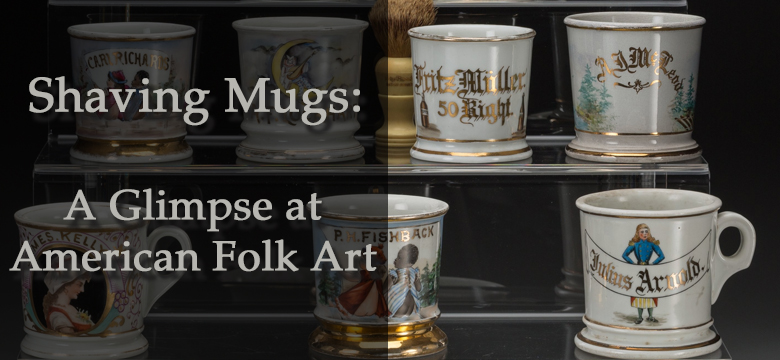In our June 26th Fine and Decorative Arts Signature Internet Session, we feature the American shaving mug collection of John Sturner. In the late Victorian era (1880-1910), most men owned a shaving mug that they kept at home or at a barbershop. Barbershops at the time were social spaces, where for only the cost of a dime you could relax while reading the Post, chat with friends and business associates, have a smoke, and get a hot-towel shave in one sitting. Mugs were made from a variety of materials including porcelain, milk glass, copper, silverplate, and tin, and would hold a cake of soap which could be worked into a rich lather with a bristle-haired brush. Considered by many collectors as American folk art, these shaving mugs are classified into five distinct groups: gold name/number, floral, decorative, fraternal, and occupational. The Sturner collection offers examples of each, with a heavy emphasis on occupational mugs.
Mugs which display one’s chosen trade are colloquially known as “occupational mugs” and are highly sought after by the collecting community. The mugs were issued blank, often imported from France and Germany where the quality of porcelain was better. The mugs were then retailed through individual shops via catalog and mail order. Occupational mugs were the most expensive type of mug one could buy (often costing as much as a day’s wages at $2.50), and each was hand-painted by a skilled artist. Decorators also offered the options of gilding, custom portraiture, photographic transfer, and more. Outside of practical purposes, the mugs served as status symbols within a community and for many, one’s trade was the penultimate prestige. In addition to the exultation of its owner, occupational mugs were prized by barber shops as an advertisement of the influential community leaders that patronized the business. In addition to the personal history the mugs tell, each provides a glimpse into everyday life of the era, when horse-drawn carriages and wagons were still the primary means of transportation. The collection boasts such rarities from milliners, telegraph operators, watchmakers, grocers, bakers, carpenters, and more.
Shaving mugs fell out of favor with the general public after the King Camp Gillette company was awarded a contract in World War I to supply American troops with double-edge safety razors as part of the standard field kit. After the conclusion of the war, the soldiers were allowed to keep the razors, and also retained their less formal shaving habits. In 2005, Vice President of Special Collections Nick Dawes appraised a similar mug collection on Antiques Roadshow in Los Angeles, which you can read about here.
By Nathan Shults
